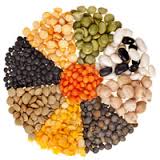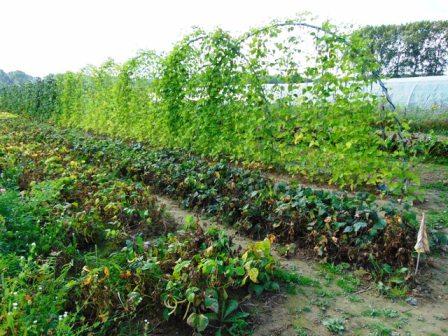Legumes (peas, beans) are protein -rich fruits (seeds) that belong exclusively to the pea family (Fabaceae). They are 4 x quite interesting:
they contain lots of proteins,
are easy to dry and store very long
bind themselves nitrogen from the air into the soil and
the straw is fine fodder.
 In archaeological sites around Çayönü peas from around 8,500 to 8,000 BC. were dated.
In archaeological sites around Çayönü peas from around 8,500 to 8,000 BC. were dated.
In Switzerland were found pea seeds that are more than 5,000 years old.
The (feed) peas / field beans can be grown fine along with grain. They do nitrogen fixation and have a high crude protein content. Winter cereals provide support and suppress the weeds at the young crop. The yield of intercropping is usually higher than if they are grown separately.
Seed is often picked up by birds. Chitting helps, it makes the seeds bitter. Pre germinating and planting can also. Deep planting can reduce the damage. Sprinkle prunings and twigs on the seed trench. Or use bird nets.
The seeds soaking overnight accelerates germination.
As soon as the first true leaf pair is formed, the plant can be earthed up.
High plants are climbing up on support (twigs, fence..). The crop is sensitive to wind. Create double rows, all touching each other above to supports.
Climbing plants need support to grow up, the own stems cannot support the plant.
The vine and ivy are called (self) sutures or clingers. They use suction cups or air roots that leave marks on the support (eg facade) when they are removed.
A climber grows in spiral form around a support. They are species-specific left or right-winding. In addition to ornamental shrubs such as wisteria or honeysuckle, we also have stake beans in the garden.
Rankers include vine and forest vine, but also cucumber, pickle and climb peas.
Young legumes are tastier and sweeter. Suitable types are then eaten in the pod. As they get older and tougher, you can still hang them to dry the harvest. Immature pods have a fleshy pericarp. Upon maturation is that thin and membranous.
If you eat the fruit in pods of ancient varieties you need to remove the tip, the tail and the "wire" (the fibrous connection between the two halves pods).
Will you keep them dry, then harvest only when the lower pods are yellow and the grains hard. You can also join them and hang (reversed) to dry, or to get later the seeds by threshing.
You can put the pods (with or without foliage) in a pillowcase and quite clobber (against the wall, trample on them, with a rolling pin...) in order to thresh out the seeds.
Chop or cut the leaves just above the ground as animal feed, animal bedding, mulch or compost material. The roots remain in the ground, causing the nitrogen remains available for the next crop.
Dried seeds can be soaked quite a day before use.
Pea or bean?
Pulses with a kidney shape are beans, and round seeds (usually green) are called 'pea'.
Peas have tendrils which they cling and sway (as gherkins, grape). High beans wind their stalk spiraling up around a pole.
The cotyledons (first germinating leaves) of peas unfold under the ground, the cotyledons of beans above.
The Romans called the Germanic peas 'Ervum", a corruption of the Arabic 'arvo' (cap).
Gregor Mendel used frequently peas for genetic studies.
Peas
The pea (Pisum sativum) is rich in vegetable protein, carbohydrates, iron, vitamins and dietary fiber. They are used in vegetarian cuisine as meat substitutes.
They are harvested when immature sugars have not been converted into starch. As a result, they have a sweeter taste.
In the Far East, the roasted and salted pea is eaten as a snack. In England, the field peas are used in a traditional pudding dish.
Peas germ already at 1°C and continue to develop at 5°C.
There are many variations, like wrinkle pea, shocking blue, gray pea or capuchin pea, round green peas (field peas), yellow pea, cherry shock and sugar peas (sugar snaps).
The garden or field pea (Pisum sativum convar. Medullare or convar. Glaucospermum) has wrinkled and smooth varieties. In those peas, the pods have inside a parchment -like membrane. Young peas are therefore removed from the pod or unshelled.
Slumber peas (? No English translation found) (Pisum sativum convar. Axiphium var. Macrocarpon) have no tough layer on the inside of the pod. The young pods you eat complete with the still immature peas inside. The pod wall is stretched tightly around the seeds, you can see the seeds in the corrugated pod. In a (too) late harvest, the thicker peas are used as garden pea.
Sugar Peas (Pisum sativum convar. Axiphium var. Saccharatum) have thick, juicy pods with large, sweet peas. They are in their entirety to eat as slumber peas.
Split peas are green, dry peas, which were stripped from the seed coat, which splits the seeds in halves. They are pre-soaked and typically processed in pea soup.
Tall varieties are more labor intensive, but you can gain more peas in a small area. High peas (long straw or stick peas) need climbing equipment and support. Some breeds are 2 m high. Use gauze or twigs (branches).
Low (stem peas) remain less than 120 cm, and bush peas are shorter than 60 cm.
Purple podded Capuchin-peas ((purple) field peas, pea shocker, pale pea or gray pea) are vines with purple flowers, the pods are blue / purple. They have a curved pod having from 1 to 10 seeds.
Chickpea, or garbanzo (Cicer arietinum) has two to three peas in the about 3 cm long pod. They are subtropical and more than 400 mm annual rainfall is required. They can grow in a temperate zone, but the yield is low. Known products are chickpea hummus and falafel. Roasted they can also be eaten as a snack.
Roman orator Cicero was called 'pea' because one of his ancestors allegedly had a wart in the form of a pea on his nose. Cicer arietinum finds his origin in his name..
Lentil (Lens culinaris) requires a lot of heat and is here only under glass (or tunnel) grown. The seeds can have several colors and sizes. The Bible tells how Esau sold his birthright to his brother Jacob for a bowl of lentil soup.
Beans
 Beans (Phaseolus vulgaris) have more than 4,000 species and many colors: purple, brown, green, yellow, white, spotted, azuki beans, lima beans, mung beans, flageolet beans and kidney beans. Black and red (kidney) beans we know especially from the chili con carne.
Beans (Phaseolus vulgaris) have more than 4,000 species and many colors: purple, brown, green, yellow, white, spotted, azuki beans, lima beans, mung beans, flageolet beans and kidney beans. Black and red (kidney) beans we know especially from the chili con carne.
Beans were brought from Peru and the southern United States until after 1550.
Growing beans begins after the late spring (mid-May), because they do not tolerate cold (frost).
Biologically peanuts (Arachis hypogaea) are no nuts, but also beans.
The broad bean or field bean (Vicia faba) is very popular with aphids. She has narrow leaves, a sturdy stem and solid standing pods. (Bush Beans have broad leaves and wide hanging fruit.) You can cook the young buds as a vegetable, the first beans use as green beans, the larger caps and the older bake and salt as a snack.
Low beans are 40-50 cm high and are also called shrub or bush beans.
High beans wind their long stem 2 or 3 m high around a support. For stick- or pole bean yields per m2 is higher.
You can use wire mesh, bamboo, a stake (with a bicycle wheel on top) and ropes,...) If the structure is too low, the plants form at the top a tangle in which fungi thrive.
On wooden bean stakes fungal spores (and mites) can remain that pose a risk to the cultivation of the next year. You can burn them by drawing the stakes trough a flame.
Sow on the inside of each stake in a semi-circular groove at a few centimeters of the stake each 4 cm, a total of 3 to 6 seeds.
Of 'dry beans' dry seed is harvested.
The common beans (Phaseolus vulgaris (garden-, French,… bean)) have large fleshy pods. The whole pods with immature seeds in it is broken, eaten chopped or sliced .
With 'beans' are usually green beans or French beans (Phaseolus vulgaris) intended.
Butter beans (Phaseolus vulgaris) are the same beans with yellow pods.
Bacon beans (Phaseolus vulgaris) are grossly Trench beans, which are eaten as string beans. They are sweeter, very big, round and fleshy and yield more than green beans. They can also be used as dry bean.
Runner beans (Phaseolus coccineus) were given many different names. They have a rhizome, which is quite unique for a bean. A known variety are farmer toes (big seeds). They are much stronger and more resistant to inclement weather. Runner beans are perennial: you can carefully excavate and keep them in a frost-free place to put them in the spring back outside. So you can harvests earlier. (The thickened roots would also be edible.)
Soybean (Glycine max) is a fat - and protein -rich bean of which often genetically modified varieties are grown.
Cowpea (Vigna unguiculata and asparagus- or yard-long bean: Vigna sesquipedalis) are only to grow under glass here. They can be up to 80 cm long.
The phaseolus vulgaris monstrans is a self-pollinating bush bean. It has purple drawing around the navel (the place where the bean with a short stalk on the inside of the pod is attached). The typical picture on the bean is determined by the genes. Depending on what people saw in this Rorschach test they called them different names, like Monstrance or Holy bean.
Flatulence or farting can be caused by that oligosaccharides that promote the proper functioning of the large intestine. Reduce the effect is possible.
Soak the beans long, change the soaking water several times.
Buy dried beans from the recent harvest, not old.
Cook the beans in advance in unsalted water and pour the boiling water away.
You can also save beans by fermenting with lactic fermentation, such as sauerkraut.
"I 'm not a vegetarian because I love animals but because I hate plants." (A. Whitney Brown)
